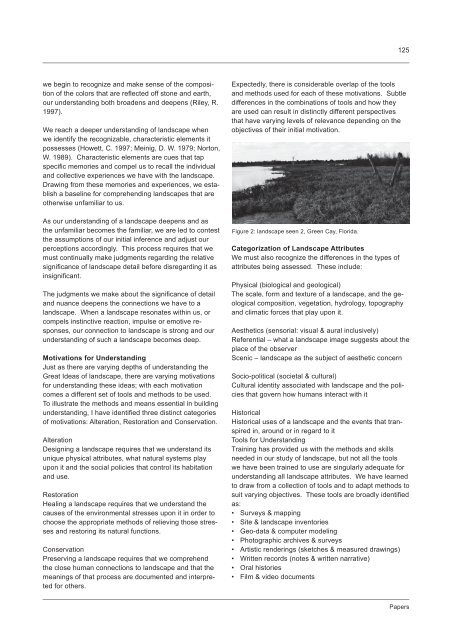Landscape – Great Idea! X-LArch III - Department für Raum ...
Landscape – Great Idea! X-LArch III - Department für Raum ...
Landscape – Great Idea! X-LArch III - Department für Raum ...
Create successful ePaper yourself
Turn your PDF publications into a flip-book with our unique Google optimized e-Paper software.
125<br />
we begin to recognize and make sense of the composition<br />
of the colors that are reflected off stone and earth,<br />
our understanding both broadens and deepens (Riley, R.<br />
1997).<br />
We reach a deeper understanding of landscape when<br />
we identify the recognizable, characteristic elements it<br />
possesses (Howett, C. 1997; Meinig, D. W. 1979; Norton,<br />
W. 1989). Characteristic elements are cues that tap<br />
specific memories and compel us to recall the individual<br />
and collective experiences we have with the landscape.<br />
Drawing from these memories and experiences, we establish<br />
a baseline for comprehending landscapes that are<br />
otherwise unfamiliar to us.<br />
As our understanding of a landscape deepens and as<br />
the unfamiliar becomes the familiar, we are led to contest<br />
the assumptions of our initial inference and adjust our<br />
perceptions accordingly. This process requires that we<br />
must continually make judgments regarding the relative<br />
significance of landscape detail before disregarding it as<br />
insignificant.<br />
The judgments we make about the significance of detail<br />
and nuance deepens the connections we have to a<br />
landscape. When a landscape resonates within us, or<br />
compels instinctive reaction, impulse or emotive responses,<br />
our connection to landscape is strong and our<br />
understanding of such a landscape becomes deep.<br />
Motivations for Understanding<br />
Just as there are varying depths of understanding the<br />
<strong>Great</strong> <strong>Idea</strong>s of landscape, there are varying motivations<br />
for understanding these ideas; with each motivation<br />
comes a different set of tools and methods to be used.<br />
To illustrate the methods and means essential in building<br />
understanding, I have identified three distinct categories<br />
of motivations: Alteration, Restoration and Conservation.<br />
Alteration<br />
Designing a landscape requires that we understand its<br />
unique physical attributes, what natural systems play<br />
upon it and the social policies that control its habitation<br />
and use.<br />
Restoration<br />
Healing a landscape requires that we understand the<br />
causes of the environmental stresses upon it in order to<br />
choose the appropriate methods of relieving those stresses<br />
and restoring its natural functions.<br />
Conservation<br />
Preserving a landscape requires that we comprehend<br />
the close human connections to landscape and that the<br />
meanings of that process are documented and interpreted<br />
for others.<br />
Expectedly, there is considerable overlap of the tools<br />
and methods used for each of these motivations. Subtle<br />
differences in the combinations of tools and how they<br />
are used can result in distinctly different perspectives<br />
that have varying levels of relevance depending on the<br />
objectives of their initial motivation.<br />
Figure 2: landscape seen 2, Green Cay, Florida.<br />
Categorization of <strong>Landscape</strong> Attributes<br />
We must also recognize the differences in the types of<br />
attributes being assessed. These include:<br />
Physical (biological and geological)<br />
The scale, form and texture of a landscape, and the geological<br />
composition, vegetation, hydrology, topography<br />
and climatic forces that play upon it.<br />
Aesthetics (sensorial: visual & aural inclusively)<br />
Referential <strong>–</strong> what a landscape image suggests about the<br />
place of the observer<br />
Scenic <strong>–</strong> landscape as the subject of aesthetic concern<br />
Socio-political (societal & cultural)<br />
Cultural identity associated with landscape and the policies<br />
that govern how humans interact with it<br />
Historical<br />
Historical uses of a landscape and the events that transpired<br />
in, around or in regard to it<br />
Tools for Understanding<br />
Training has provided us with the methods and skills<br />
needed in our study of landscape, but not all the tools<br />
we have been trained to use are singularly adequate for<br />
understanding all landscape attributes. We have learned<br />
to draw from a collection of tools and to adapt methods to<br />
suit varying objectives. These tools are broadly identified<br />
as:<br />
• Surveys & mapping<br />
• Site & landscape inventories<br />
• Geo-data & computer modeling<br />
• Photographic archives & surveys<br />
• Artistic renderings (sketches & measured drawings)<br />
• Written records (notes & written narrative)<br />
• Oral histories<br />
• Film & video documents<br />
Papers
















